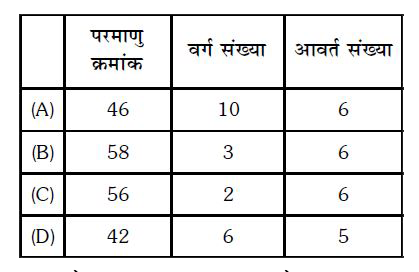(a)M−(g)→M(g)
(b)M(g)→M+(g)
(c) M+(g)→M+2(g)
(d)M+2(g)→M+3(g)
इनका I.P. न्यूनतम व अधिकतम क्रमश: होगा :-
a,d
b,c
c,d
d,a
The correct Answer is:A
Step by step video, text & image solution for (a)M_((g))^(-) to M_((g)) (b)M_((g)) to M_((g))^(+) (c) M_((g))^(+) to M_((g))^(+2) (d)M_((g))^(+2) to M_((g))^(+3) इनका I.P. न्यूनतम व अधिकतम क्रमश: होगा :- by Chemistry experts to help you in doubts & scoring excellent marks in Class 12 exams.
Topper's Solved these Questions
- BOOK - ALLEN HINDICHAPTER - आवर्त सारणी EXERCISE - Exercise-II (Previous Year Questions)32videos
आवर्त सारणी
- BOOK - ALLEN HINDICHAPTER - आवर्त सारणी EXERCISE - Exercise-III (Analytical Questions)38videos
आवर्त सारणी
- BOOK - ALLEN HINDICHAPTER - आवर्त सारणी EXERCISE - Beginner.s Box-68videos
आवर्त सारणी
- BOOK - ALLEN HINDICHAPTER - अभिक्रिया क्रियाविधि : भाग-I EXERCISE - EXERCISE -IV (ASSERTION & REASON) (TARGET AIIMS) (AIIMS 2018)5videos
अभिक्रिया क्रियाविधि : भाग-I
- BOOK - ALLEN HINDICHAPTER - उपसहसंयोजन यैगिक EXERCISE - Exercise-IV Assertion & Reason28videos
उपसहसंयोजन यैगिक
Similar Questions
निम्न में से कौनसा आक्साइड अधिक क्षारीय होता है।
01:23View Solutionनिम्न में से कौनसा सही मिलान है :-
 01:59View Solution
01:59View Solutionनिम्न में से कौनसा एक परमाणु के स्थायी विन्यास से प्रभावित होता है :-
(a) विद्युतऋणता (b) आयनन विभव (c) इलैक्ट्राॅन ग्रहण ऐन्थैल्पी
सही उत्तर है :-04:32View Solutionकथन :-m-नाइट्रोफिनॉल की तुलना में o-नाइट्रोफिनॉल ज्यादा अम्लीय है।
कारण :-o-स्थिति पर, −NO2 , का - प्रभाव m-स्थिति की तुलना में ज्यादा होता है।View Solutionकथन:K2SO4.Al2(SO4)3.24H2O विलयन अम्लीय प्रकृति का होता है।
कारण : यह आयनित होकर संकुल आयन देता है।04:00View SolutionWhich of the following requires highest energy:
a.M(g)→M⊕(g)
b.M(g)→M2+(g)
c.M(g)→M3+(g)
d.M(g)→M4+(g)View SolutionM_((g)) rarr M_((g))^(+) +e^(-), DeltaH = 100eV M_((g)) rarr M_((g))^(2+) +2e^(-), DeltaH = 250 eV which is incorrect statement?
02:36View SolutionConsider the following ionization energies for a metal M
M(g)→M+(g)+e−, ΔH=+580 kJ / mole
M+(g)→M+2(g)+e−, ΔH=+1815 kJ / mole
M+2(g)→M+3(g)+e−, ΔH=+2740 kJ / mole
M+3(g)→M+4(g)+e−, ΔH=+11600 kJ / mole
Select correct order03:27View SolutionM(g)→M+3(g)+3e−,ΔH=600eV
M+(g)→M+3(g)+2e−,ΔH=500eV
Calculate IE1of M:03:42View SolutionTwo masses m1 and m2(m2>m1) are hanging vertically over frictionless pulley. The acceleration of the two masses is :
 03:38View Solution
03:38View Solution(A) M−(g)→M(g)
(B) M(g)→M+(g)
(C) M+(g)→M2+(g)
(D) M2+(g)→M3+(g)
minimum and maximum I.P. would be:05:29View SolutionM(g)→M+(g)+e−,ΔH=100 eV , M(g)→M2+(g)+2e−,ΔH=250 eV
Which is incorrect statement ?01:50View Solution(a) M_((g))^(-) to M_((g)) , (b)M_((g)) to M_((g))^(+) , (c)M_((g))^(+) to M_((g))^(2+) , (d)M_((g))^(2+) to M_((g))^(3+) Minimum and maximum I.P. would be of :
02:36View SolutionConsider the following ionization energies for a metal M
M(g)→M+(g)+e−,ΔH=+580 kJ/mole
M+(g)→M2+(g)+e−,ΔH =+1815 kJ/mole
M2+(g)→M3+(g)+e−,ΔH=+2740 kJ/mole
M3+(g)+M4+(g)+e−,ΔH= + 11600 kJ/mole
Total no. of electron(s) in outermost shell of metal M are:03:00View SolutionConsider the following ionization energies for a metal M
M(g)→M+(g)+e−,ΔH=+580 kJ/mole
M+(g)→M2+(g)+e−,ΔH =+1815 kJ/mole
M2+(g)→M3+(g)+e−,ΔH=+2740 kJ/mole
M3+(g)+M4+(g)+e−,ΔH= + 11600 kJ/mole
Which one of the four ions has largest electron affinity?01:28View Solution

